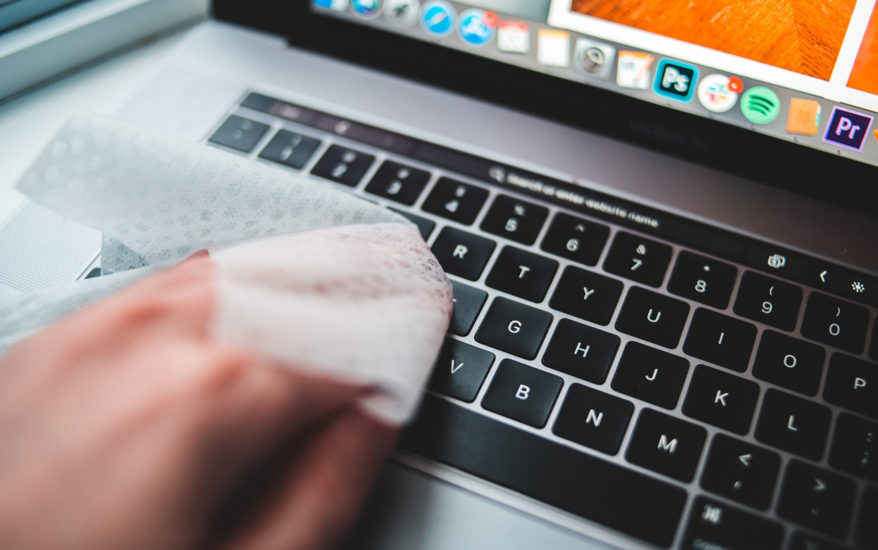
The cleanliness of our workplaces is something that is always extremely important, but in the past has often been overlooked more than it should have been. In the worldwide outbreak of Covid-19, both hygiene and wider health issues have been brought into much sharper focus.
We’re all taking new and unprecedented steps in our personal and professional lives to try and mitigate the spread of the coronavirus. Eventually, at some point in the future, things will return to normal and we will return to our normal working arrangements. And when we do, we are all likely to be much more sensitive and aware of keeping workstations, devices and shared areas like meeting rooms as clean as possible.
So what can we do to ensure better cleanliness in our working environments, and better ensure the health of our employees?
Here are some thoughts and tips to help with workplace cleanliness:
-
Mobile devices: cleanliness at your fingertips
Research conducted by the University of Arizona has found that cellphones can carry more than ten times the number of germs than the average toilet seat.
Think about it: you clean your toilet regularly, but when was the last time you properly cleaned the screen of your smartphone? When you then consider how many times you touch the screen of your phone in an average day, it’s easy to see why it can be a breeding ground for germs.
Many people use anti-bacterial or alcohol-based wipes, but according to Apple and Samsung, this can actually make the problem worse as it makes it easier for germs to attach themselves to the screen surface.
Instead, a slightly damp cloth is recommended as a better option.
However, there’s no reason why you can’t cut the supply of germs off at the source by keeping your hands – and specifically your fingertips – as clean as possible. We’ve all been encouraged to wash our hands several times daily to fight the spread of Covid-19, and keeping that regime in place once the pandemic subsides can help in maintaining a cleaner mobile device.
2. Shared spaces: take the clinical approach
With more and more of us working more flexibly and more collaboratively, we’re increasingly coming into greater contact with each other in shared spaces like meeting rooms, breakout zones or hot-desking areas. Many of these contain screens, computer terminals and other shared hardware, and so it’s imperative to maintain strong standards of hygiene with these.
That’s because all the dangers detailed above for mobile device screens are multiplied for those in shared spaces. Instead of just one set of fingers potentially transmitting germs, these pieces of equipment will be touched by five, ten or possibly even more people every single day. So any germs transmitted through them could quickly sweep through your workforce and cause significant disruption to your business.
There’s no reason why you can’t protect this kit with the same kind of regimes that would be applied in a medical setting.
Hospital-grade cleaners are widely available commercially which can disinfect hardware and kill off any bacteria or similar germs present. It may require a bit of investment on behalf of your business, but could pay off handsomely if it keeps your workforce fit and well.
3. Workstations: no such thing as a free lunch
For those of us that still work from our own dedicated workstations, whether in an office or at home, it can be very easy to slip into bad habits that quickly allow germs to spread. This is especially the case if you have breakfast, lunch or snacks at your desk.
Food crumbs that scatter across desks or fall between the keys on keyboards quickly become breeding grounds for germs, and are often given plenty of time to multiply if desks are cleaned infrequently. And if things get really bad, a desk could even become a magnet for mice or cockroaches, with all the disease that they can potentially spread.
Keeping desks and the equipment on them clean is therefore a must, and it’s recommended to clean them fully at least once a week. And for hot-desks, it’s both important and good manners to maintain hygiene for others that will use the space: washing hands, using anti-viral hand gel and cleaning up after eating at a hot-desk (if you really have to eat there) should be standard practice.
4. Hardware: the cleaner touch
Lots of equipment within office environments will be touched by lots of different people over the course of a working day. Think of items like meeting room control panels, wayfinder units or desk booking kiosks, which could potentially be touched by every single person in your building. It would therefore only take one person with an infection on their hands to pose a significant and wide-ranging health hazard, so improving your meeting room booking process and keeping these surfaces continually clean is absolutely critical.
The best solution for keeping shared screens clean is a spray with a high alcohol content (around 70% is ideal). This can be sprayed onto the screen face and wiped gently with a soft cloth, or sprayed onto the cloth and then applied to the screen surface. Alternatively, you can use specially-made surface wipes that contain a formulated mix of alcohol and bacteria-killing agents.
Of course, these substances can be harmful to other parts of the equipment, especially if they get into ventilation slots, so careful application is very important. And whatever you do, don’t use bleach…



